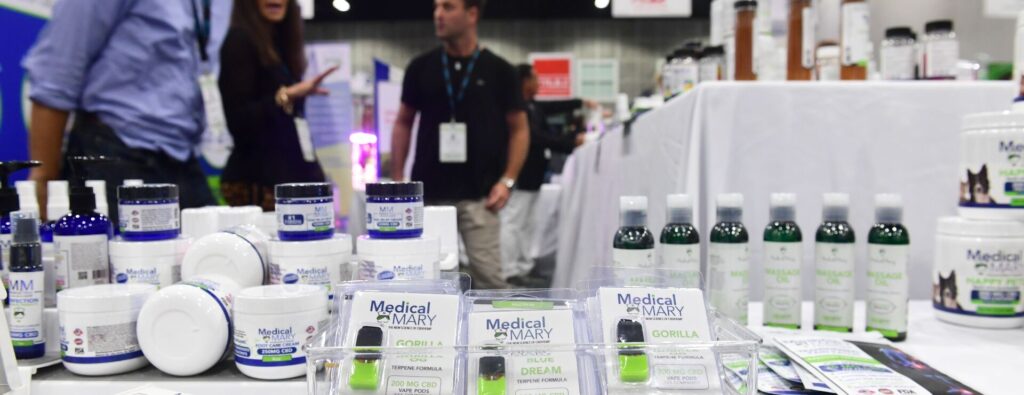A display of CBD infused foot cream, vape pods, and massage oil products from Medical Mary are viewed at the 6th Annual Cannabis World Congress and Business Expo in Los Angeles in 2019.
FDA to work with Congress to develop harm reduction approach.
Agency also continuing look at how marijuana is classified.
The Food and Drug Administration intends to collaborate with Congress to devise a harm reduction approach to potential regulatory pathways for cannabidiol products, an agency official said Wednesday.
The FDA believes a new pathway for cannabidiol products is needed to protect consumer safety given CBD’s inherent risk profile and the limited risk management options that exist underthe current food ingredient and dietary supplement pathways, Norman Birenbaum, a senior public health adviser for the FDA’s Center for Drug Evaluation and Research, said at a Food and Drug Law Institute conference.
“A new pathway could implement much-needed standards over the largely unregulated industry to help people understand and manage and reduce their risks if they choose to use these products and to make more informed choices about their health overall,” Birenbaum said.
The surging market for CBD products will reach $16 billion by 2025, according an estimate by Brightfield Group, a leading research firm serving the cannabis and CBD industry.
As part of a harm reduction approach, basic oversight measures could be established to prevent contamination across product standards and manufacturing practices, Birenbaum said. Additional safeguards could include clear labels, CBD content limits, and measures to prevent child ingestion.
With a new framework, inhalable hemp products such as vapes could meet the definition of an FDA-regulated product type that receives FDA oversight, he said. A framework would also provide regulatory clarity and certainty around products for animals to decrease the risk of unknowing exposure to CBD through meat and milk products.
Meanwhile, the Department of Health and Human Services continues to reassess the status of marijuana under the Controlled Substance Act, Birenbaum said.
A priority for the FDA is to conduct an eight-factor analysis to provide scheduling recommendations for marijuana substances to the Drug Enforcement Administration, Birenbaum said. The DEA classifies drugs, substances, and certain chemicals into five schedules depending on their acceptable medical use and potential for abuse or dependency.
It will be the HHS’ responsibility to make three findings necessary to the overall scheduling recommendations, he said. These include assessing the drug’s abuse potential, determining its medical use, and examining the drug’s safety under medical supervision and its dependence potential.
“FDA will apply public health considerations to its assessments and scheduling recommendations regarding cannabis and marijuana,” Birenbaum said.
He said the FDA will continue to work with state regulatory partners as needed and closely monitor the market and act within its authority, as well as issue warning letters to companies that market hemp-derived products for diseases or other nonproven therapeutic uses.
Call for ‘Sensible Regulations’
Aaron Smith, cofounder and CEO of the National Cannabis Industry Association, said he supports the harm reduction approach but also advocates for separate “sensible regulations” for different cannabis products. He suggested psychoactive cannabis for adult use should be treated like alcohol, while non-intoxicating products such as CBD should be regulated by the FDA under the Food, Drug and Cosmetic Act.
Under the Controlled Substance Act, marijuana and delta-9- tetrahydrocannabinol (THC) are Schedule I substances, which are not accepted for medical use and have a high potential for abuse. Across the country, 37 states have legalized the medical use of marijuana to varying degrees, and four states— Georgia, Texas, Wisconsin, and Wyoming—have legalized the medical use of CBD with THC only.
“Our view is that the federal government needs to align with state law and the best way to do that would be to remove cannabis from Schedule I status, and then begin regulating the products in a way when it’s appropriate,” Smith said.
Paul Armentano, deputy director of National Organization for the Reform of Marijuana Laws, said placing marijuana in a lower schedule would to “rectify the existing chasm” between state and federal marijuana law.
“The threat of federal interdiction in this industry would go away. It would therefore bring greater certainty to the markets themselves and the players in those markets now that the threat of federal prosecution or disruption of their markets has been removed. It would allow for financial institutions that currently aren’t working with the state licensed entities to do so,” Armentano said.
Jensen N. Jose, regulatory counsel from Center for Science in the Public Interest, said in the interview that FDA or the designated regulatory agency overseeing CBD products should receive increased resources and authority to ensure safer market regulation.
He said a premarket review process is needed for approving CBD uses and their interactions with other ingredients so that the FDA can predict risks to avert potential harm. Jose added that creating standards for maximum serving sizes or daily intakes would help regulate CBD products.
Both Smith and Armentano said a consistent standard on testing the purity of CBD products is necessary to address problems with mislabeling as independent testing consistently uncovers significant disparities in CBD percentages, THC content, and undisclosed ingredients.



